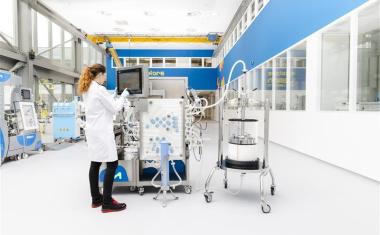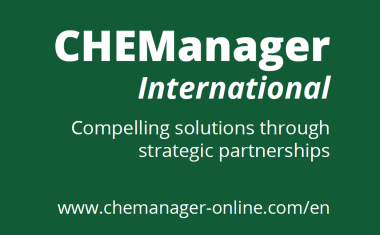The Future of Outsourcing
The increasing complexity in drug development and the highly competitive industry landscape are creating a dramatic shift in how pharmaceutical and biotech companies plan for and execute drug development and production.

Speed, quality, and cost continue to be critical levers, but the challenge of achieving the right balance under the growing pressure to expedite development has made selecting the “right” outsourcing partners a strategic priority for pharmaceutical and biotech companies.
With increased market expectations and new and more stringent regulatory hurdles, these companies are also seeking advanced supply chain opportunities to optimize the development of their molecules. For many, establishing a partnership with a contract development and manufacturing organization (CDMO) is more cost effective than investing internally on infrastructure.
Outsourcing offers drug sponsors a variety of benefits, including access to a global network of cGMP facilities with high capacity and highly qualified experts across multiple disciplines. Having access to such vast industry expertise facilitates the seamless transition of projects through all phases of development.
This is especially critical for small and mid-size companies that don’t have the in-house capabilities needed to support the capacity needs and time constraints, or the technical and regulatory knowledge or resources to successfully plan for and file an investigational new drug (IND)/ investigational medicinal product (IMPD) for their regional and global launches.
As precision medicine becomes more pervasive, the benefits of CDMO outsourcing are expanding by an order of magnitude for both small biotech companies and large pharma. The active pharmaceutical ingredients (APIs) and formulations developed for precision drug products are often drastically more complex and require specialized handling. While large pharmaceutical companies often have the capacity and knowledge to keep this work in-house, the small batch size requirements of precision therapies make it impractical.
To address these needs, more companies are turning to outsourcing all or part of their drug development and manufacturing projects.
A recent CPhI report entitled “The Future of Outsourcing — Strategies for Partner Selection” assessed these options as well as the overall market to see how outsourcing strategies are now evolving.
Outsourcing Strategies
The CDMO market continues to do extremely well and is growing significantly in all regions of the world. The Covid-19 pandemic and the consequential need to develop and manufacture new drugs, vaccines, and delivery platforms has further accelerated this growth. Yet running alongside Covid-driven growth, a record number of new drugs are entering development.
But how do both large pharmaceutical companies and, perhaps more importantly, the growing number of smaller innovators approach their outsourcing strategies?
Putting aside the option of in-house development, innovators must consider whether it is better to go for a two-CDMO strategy (i.e., one for drug substance and one for drug product), a larger full-service provider, or to work with a specialist integrated development partner earlier before re-reviewing their options in Phase I or II.
However, what is almost universally relevant to the situation biotechs encounter today is that they need to make and evaluate these decisions much earlier than before, as there is no guarantee there will be capacity immediately available when they need it.
Phase-Appropriate Development
With innovators increasingly turning to compressed timelines, development methods are shifting in response, the CPhI report states. For example, phase-appropriate development — whereby an innovator seeks to advance to just the next key milestone as quickly as possible — is still seen in the marketing of the majority of CDMOs.
Traditionally, outsourcing strategies were designed to help secure next stage funding, but many biotechs and small pharma companies are now entering development with more robust cash flows and the ability to plan further downstream and develop a product’s roadmap from discovery to commercial launch.
Developing an IND strategy with the end submission in mind is how a drug sponsor shrinks their time to market and lowers program risk. Decisions made in early development have downstream implications and failing to plan for scale-up and commercialization can lead to time-intensive redoes and revalidation work.
At this stage the quality presentation often becomes the sticking point. Therefore, the report concludes, phase-appropriate development in accelerated development seems to be a thing of the past.
Asian Strategies
Another approach to emerge in recent years could be referred to as a hybrid Asian strategy, according to CPhI’s experts. This hybrid model entails not only completing API development in Asia and the finished product in the US or Europe, but also the API component as well. This means essentially bringing in some of the cost advantages of Asian chemistry services and manufacturing, while completing later intermediate or final API steps in western markets.
A more traditional variant of the Asian model is to have discovery and integrated development until Phase I or II before transferring processes over.
Biotechs Go Longer into Development than Before
Overall, biotechs are approaching CDMOs with a more fleshed-out roadmap and the intention of advancing further from the offset, as many life sciences venture investors recently raised new funds and have plenty of cash to put to use.
To this end, investors are becoming more involved in their biotech’s development and outsourcing strategy, as this has fundamental implications for when and how they can exit. The report therefore anticipates that early-stage investors may start to bring in CMC consultants to map out the outsourcing approach as early as pre-clinical. A promising target is not enough on its own, it needs to be backed up by a robust development plan.
Alternative Partnering Strategies
The term CDMO covers quite a broad range of activities, with ”D” taking dominance from the offset before “M” ultimately decides the long-term supply partner, the report states. One newer approach that is on the rise adds an additional process development partner, possibly a chemistry focused CRO, into this mix. Such a company might work with the innovator on chemistry and improvements, potentially even as far as commercial launch. This does mean adding an additional partner, but if the relationship is cooperative and information is shared, this could be a very strong triangle.
Biotech vs. Big Pharma
Large pharmaceutical companies generally have in-house CMC experience and options in terms of how they approach their outsourcing. Consequently, the greatest difference in outsourcing strategy between Big Pharma and biotechs is the role outsourcing plays in the company’s business strategy. Where Big Pharma may only want to outsource a limited component, biotechs generally see outsourcing as a fundamental part of their business plan.
Not surprisingly, CPhI experts believe that the latter approach — which fosters deeper partnerships — will always have the most value for CDMOs.
For big pharma companies with multi-target programs, it is feasible to look at just the largest and most capable partners and select according to their needs. But for biotechs, securing the development capabilities they don’t have is the highest priority, at least initially.
Is all Capacity Equal?
As already noted previously, capacity in the contract services space is constrained and has been for some time. Before the Covid-19 pandemic hit, contract organizations were already reporting long waiting lists for their services, particularly as clinical activity for cell and gene therapies surged. Now the industry is faced with pandemic-induced backlogs in addition to pre-existing constraints.
The small molecule market, the CPhI report says, experienced unprecedented growth in 2020, exacerbating capacity issues. However, due to the sheer number of CDMOs that offer small molecule services (according to the report 90% of all CDMOs worldwide are engaged in small molecule manufacturing), getting a place in the queue is generally easier than with other drug types.
Turning to large molecules, it is worth noting that the majority of development and manufacturing falls under the mammalian category, and outsourcing is common in this market segment. In addition to industry-wide capacity constraints, large molecule projects have been impacted by shortages of glass vials, syringes and stoppers, caused by the global Covid-19 vaccine push.
Finally, advanced therapy medicinal products (ATMPs) such as cell and gene therapy represent a much smaller share of CDMO activities. Contract organizations are immensely popular in this segment, with some reports showing a higher percentage of outsourcing in cell and gene therapy than any other field. In addition to industry giants, there are several specialty CDMOs carving out a niche in the cell and gene marketplace.
Most Effective Outsourcing Strategies
As explained before, the sector has been shifting away from phase-appropriate development in favor of a more forward-looking model. It should therefore come as no surprise that the industry experts involved in the CPhI report advise starting the search for an outsourcing partner early on and with a general roadmap in hand to narrow down the options.
Early engagement can be particularly beneficial for smaller companies who stand to benefit from the outsource partner’s experience.
Multi-Vendor vs. Integrated Services
When considering potential CDMO partners, drug sponsors also need to decide whether to take a multi-vendor approach, where they work with more than one partner, opt for an integrated services solution that handles the process from start to finish, or just engage an outsource partner for a very limited part of the process. The suitability of each option will likely depend on a few factors, such as the size of the sponsor company, the type of expertise required, and the desired time to market.
Smaller CDMOs will likely have areas they specialize in — such as analytical method development or process characterization — while larger CDMOs can muster greater resources to support or lead key development activities. In the end the data must meet the expectations of the intended regulatory authority.
According to the CPhI report, for drug sponsors who lack experience managing CDMO relationships, selecting one vendor who can provide expertise across a range of services can simplify the process. In this case, sponsors are able to map out the entire product journey and if there is a delay in one phase, timelines can be easily adjusted.
This is more complicated with a multi-vendor approach, as the sponsor retains complete responsibility for keeping the project on track. In the case of a delay or unexpected change, the sponsor must communicate with multiple vendors, sometimes working in parallel, and adjust timelines across multiple projects.
The ability of a sponsor to communicate through one central channel is a significant benefit of the integrated services model. As integrated offerings may not be able to provide the same level of expertise across all stages of development, sponsors should consider whether capabilities or speed are more important to their individual project.
Mid-sized outsource partners may be a better fit for highly nimble biotechs who accept the added complexity of working with multiple vendors as a trade-off for quality and cultural alignment.
One CPhI expert states that there is a giant divide between the really small players and the really big ones. There’s not a lot to bridge that gap, and this is causing a discontinuity in the market because the smaller players don’t necessarily have integrated solutions and cannot provide a fully strategic outsourcing solution to their biotech and big pharma customers. However, culturally, they match up extremely well, particularly with the small, medium and virtual pharma companies. These smaller players tend to be entrepreneurial, fast paced, lack bureaucracy, and have a very strong depth of expertise, albeit in a very narrowly focused window. Therefore, it can be a very valuable proposition.
Outlook
Given the current level of demand, the CPhI report predicts that the CDMO market will continue on its current trajectory and the challenges addressed will not only remain relevant but will become even more critical. All CDMOs are expanding, and the CPhI experts foresee that perhaps some of today’s niche players will quickly grow to become mid-sized CDMOs to fill the current major disparity in the overall market. (rk)















